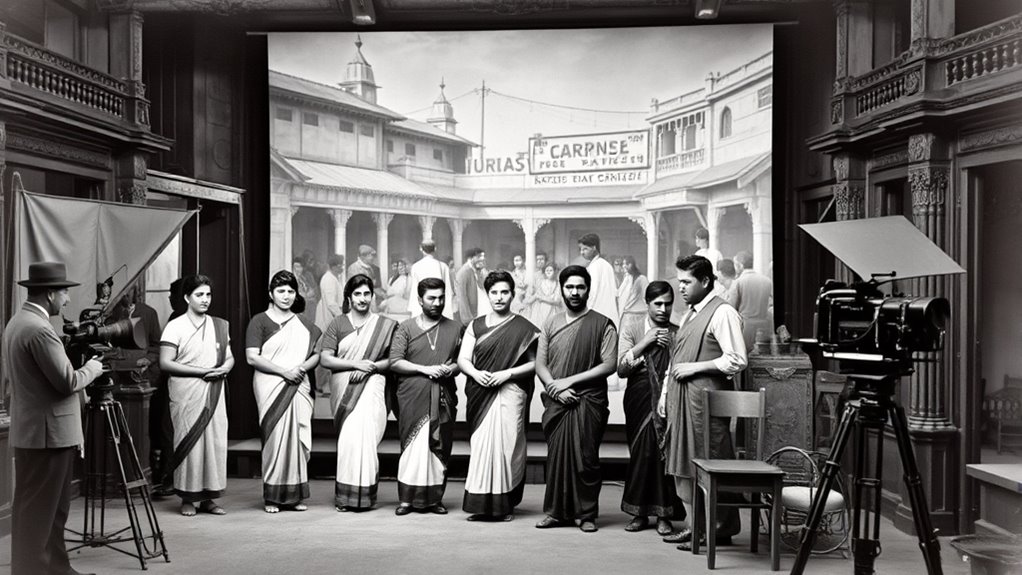India’s silent film era began in the early 20th century, marking the country’s first steps into global cinema with storytelling through visuals, expressive acting, and intertitles. During this time, filmmakers faced technological challenges, and many films were lost or damaged over time due to fragile nitrate stock. When sound technology arrived in the late 1920s, silent films quickly faded away. If you explore further, you’ll discover how these early films shaped India’s cinematic history and cultural legacy.
Key Takeaways
- India’s silent film era began in the early 20th century, relying solely on visuals and expressive acting before sound technology was introduced.
- Silent films faced preservation challenges due to fragile nitrate stock and lack of early awareness about safeguarding cinematic heritage.
- The late 1920s marked the transition to sound films, leading to the decline and eventual disappearance of many silent classics.
- Despite the absence of dialogue, silent films significantly influenced India’s visual storytelling techniques and cinematic artistry.
- Modern efforts focus on digitizing and restoring silent films to preserve India’s cultural and cinematic history for future generations.

The silent film era in India began in the early 20th century, marking the country’s debut on the global cinematic stage. During this period, movies relied solely on visuals, intertitles, and expressive acting to tell stories, since sound technology hadn’t yet been developed for Indian audiences. You might not realize it, but this era laid the foundation for India’s rich film culture, even without synchronized sound. As filmmakers experimented with storytelling techniques, they also faced the challenge of preserving these early works amid the technological limitations of the time. Film preservation became an essential concern because many of these silent films were shot on fragile nitrate stock, which was highly flammable and prone to deterioration. Without proper preservation, countless silent films from India’s early cinema history could have been lost forever, erasing a fundamental part of cultural heritage. Film preservation techniques and awareness gradually increased as the importance of safeguarding these works became more recognized.
During this period, film preservation wasn’t prioritized due to a lack of awareness and resources, making it difficult to safeguard these early works. However, the advent of sound technology in the late 1920s brought seismic changes to Indian cinema, but it also highlighted the importance of film preservation. As sound films gained popularity, silent films quickly fell out of view, and many were discarded or deteriorated over time. Today, restoring and preserving these silent classics has become a priority for historians and archivists. They recognize that these films offer unique insights into India’s social, cultural, and artistic history, even without synchronized dialogue. Efforts to conserve silent films involve digitization and careful restoration, ensuring that future generations can access and study these foundational works.
The changeover from silent to sound cinema marked a turning point, but the silent era’s impact remains significant. It was during these formative years that Indian filmmakers learned the language of visual storytelling, which still influences Indian cinema today. Sound technology transformed the industry, but it also underscored the need for diligent film preservation. Without preserving these silent films, much of the early cinematic artistry and history would be lost. As you explore India’s silent film era, you come to understand how imperative it was to document these early efforts, despite the technological limitations. Preserving these films isn’t just about safeguarding old footage; it’s about honoring the origins of Indian cinema and ensuring that the stories told in silence continue to speak across generations.
Frequently Asked Questions
How Did Silent Films Influence Indian Cultural Identity?
Silent films played a essential role in shaping India’s cultural identity by showcasing local stories and traditions, creating a strong sense of cultural preservation. You see, their musical influence helped express emotions and cultural nuances without spoken words, making stories accessible across diverse languages. As a result, silent films fostered a shared cultural experience, strengthening national identity and laying the foundation for India’s future cinematic development.
What Were the Main Technical Challenges of Silent Filmmaking in India?
You face enormous technical challenges in silent filmmaking, like perfecting film tinting to evoke emotion and ensuring camera mobility to capture dynamic scenes. These obstacles seem monumental, almost insurmountable, especially with limited technology. Achieving seamless tinting and fluid camera movements required ingenuity and patience. Despite these hurdles, filmmakers pushed boundaries, creating visually compelling silent films that laid the foundation for future Indian cinema’s evolution.
Who Were the Pioneering Actors and Directors of India’S Silent Era?
You’ll find that pioneering actors like D. P. Khaitan and J. S. Joshi brought silent films to life with expressive performances. Influential directors such as Raghupathi Venkaiah Naidu and D. W. Griffith shaped early Indian cinema’s visual storytelling. Their innovative techniques and dedication laid the foundation for the industry, bridging cultural gaps through silent storytelling and inspiring future filmmakers. Their work remains a crucial chapter in Indian cinematic history.
How Did Silent Films Impact Regional Languages and Dialects?
Imagine silent films as bridges connecting diverse islands of regional dialects. You see, they helped preserve local languages by relying on expressive visuals and intertitles, reducing dependence on spoken words. This made regional dialects more prominent, fostering cultural pride. As a result, silent films played a crucial role in language preservation, ensuring that each dialect thrived alongside the universal language of cinema, enriching India’s linguistic tapestry.
Why Did the Silent Film Era Decline in India?
You might notice that the silent film era declined in India due to technological advancements like synchronized sound, which improved storytelling and audience engagement. Additionally, colonial policies favored Westernized entertainment, pushing silent films out of popularity. As sound technology became affordable and accessible, filmmakers shifted to talkies, making silent films less relevant. This change marked the end of India’s silent-film era and the rise of sound cinema.
Conclusion
As you reflect on India’s silent-film era, you realize how silence spoke volumes, how images conveyed emotion without sound, and how stillness captured stories better than words ever could. You see that in silence, there’s strength; in stillness, there’s motion; in absence, there’s presence. Embracing this silent chapter, you understand that sometimes, what’s left unspoken can be the most powerful voice of all. Silence, after all, is a language of its own.









